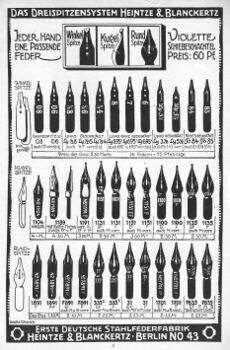Differenze tra le versioni di "Heintze & Blanckertz/en"
(Creata pagina con "In 1935 it was turned into a war industry. Towards the end of the Second World War it was destroyed by bombing, and the remains were later dismantled by the Red Army. The...") |
|||
| Riga 8: | Riga 8: | ||
From [[1913]] he set up his own rolling mill and became the major German manufacturer of steel nibs. | From [[1913]] he set up his own rolling mill and became the major German manufacturer of steel nibs. | ||
| − | + | In [[1935]] it was turned into a war industry. Towards the end of the Second World War it was destroyed by bombing, and the remains were later dismantled by the Red Army. The company was refounded with offices in Berlin and Frankfurt, but later the Berlin office was confiscated by the authorities of the Soviet sector of the city. | |
| − | |||
La sede di Francoforte rimase di proprietà della famiglia Blanckertz, continuando a produrre strumenti per la scrittura e le belle arti. La sede di Berlino, invece, divenne nel [[1949]] la [[VEB Berliner Schreibfeder]] ("VEB" indica le imprese statali). | La sede di Francoforte rimase di proprietà della famiglia Blanckertz, continuando a produrre strumenti per la scrittura e le belle arti. La sede di Berlino, invece, divenne nel [[1949]] la [[VEB Berliner Schreibfeder]] ("VEB" indica le imprese statali). | ||
Versione delle 22:45, 4 apr 2023
The company</noincludeonly> was founded in 1849 (according to Wikipedia, "preisgekrönt 1862" is the date on some nib packages) by Rudolf Heintze and Heinrich Blanckertz in Oranienburg, initially producing linoleum, then distributing dip nibs. Around 1867 Rudolf Heintze left the company and Heinrich Blanckertz became the only owner.
Initially the company was based at Heiligegeiststraße 13. Around 1856 Blanckertz acquired the property at Fliederstraße 4 in Friedrichshain. Around 1872 the property at Gollnowstraße 11 was added and, from 1889, the property at Georgenkirchstraße 44.
In 1887 Rudolf Blanckertz joined his father's company as a representative and engineer and in 1898 founded the Rudolf Blanckertz Type Museum. After his father's death in 1908, Rudolf Blanckertz became the owner of the company and had a steel mill built in Oranienburg in 1912. From 1913 he set up his own rolling mill and became the major German manufacturer of steel nibs.
In 1935 it was turned into a war industry. Towards the end of the Second World War it was destroyed by bombing, and the remains were later dismantled by the Red Army. The company was refounded with offices in Berlin and Frankfurt, but later the Berlin office was confiscated by the authorities of the Soviet sector of the city.
La sede di Francoforte rimase di proprietà della famiglia Blanckertz, continuando a produrre strumenti per la scrittura e le belle arti. La sede di Berlino, invece, divenne nel 1949 la VEB Berliner Schreibfeder ("VEB" indica le imprese statali).
Materiale disponibile:





